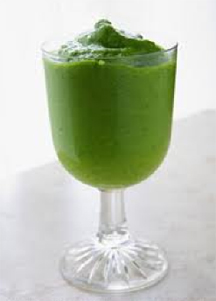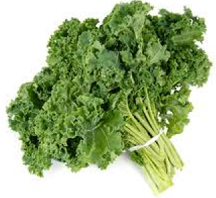No More Blood Sugar Blues:
Greens are the Way to Go!
By Alice Osborne
 1. Fatigue. The most common feature of Insulin Resistance is that it wears people out. Some are tired just in the morning or afternoon, others are exhausted all day.
1. Fatigue. The most common feature of Insulin Resistance is that it wears people out. Some are tired just in the morning or afternoon, others are exhausted all day.
2. Brain fogginess. Sometimes the fatigue of Insulin Resistance is physical, but often it's mental. The inability to focus is the most evident symptom. Poor memory, loss of creativity, poor grades in school often accompany Insulin Resistance, as do various forms of "learning disabilities."
3. Low blood sugar. Mild, brief periods of low blood sugar are normal during the day, especially if meals are not eaten on a regular schedule. But prolonged periods of this "hypoglycemia," accompanied by many of the symptoms listed here, especially physical and mental fatigue, are not normal. Feeling agitated, jittery and moody is common in Insulin Resistance, with almost immediate relief once food is eaten.
 4. Intestinal bloating. Most intestinal gas is produced from carbohydrates in the diet. Insulin Resistance sufferers who eat carbohydrates suffer from gas, lots of it.
4. Intestinal bloating. Most intestinal gas is produced from carbohydrates in the diet. Insulin Resistance sufferers who eat carbohydrates suffer from gas, lots of it.
5. Sleepiness. Many people with Insulin Resistance get sleepy immediately after eating a meal containing more than 20% or 30% carbohydrates. This means typically a pasta meal, or even a meat meal which includes potatoes or bread and a sweet dessert.
 6. Increased weight and fat storage. For most people, too much weight is too much fat. In males, a large abdomen is the more obvious and earliest sign of Insulin Resistance. In females, it's prominent buttocks.
6. Increased weight and fat storage. For most people, too much weight is too much fat. In males, a large abdomen is the more obvious and earliest sign of Insulin Resistance. In females, it's prominent buttocks.
7. Increased triglycerides. High triglycerides in the blood are often found in overweight persons. But even those who are not overweight may have stores of fat in their arteries as a result of Insulin Resistance.
These triglycerides are the direct result of carbohydrates in the diet being converted by insulin.
 8. Increased blood pressure. It is a fact that most people with hypertension have too much insulin and are Insulin Resistant. It is often possible to show a direct relationship between the level of insulin and blood pressure: as insulin levels elevate, so does blood pressure.
8. Increased blood pressure. It is a fact that most people with hypertension have too much insulin and are Insulin Resistant. It is often possible to show a direct relationship between the level of insulin and blood pressure: as insulin levels elevate, so does blood pressure.
9. Depression. Because carbohydrates are a natural "downer," depressing the brain, it is not uncommon to see many depressed persons who also have Insulin Resistance. This was a huge problem for me, which really motivated me to make some changes in diet and exercise (or lack thereof).
Different cells respond to insulin differently. Some cells are more resistant than others, as some cells are incapable of becoming very resistant. The liver becomes resistant first, followed by the muscle tissue and lastly the fats. As all these major tissues, become insulin resistant your pancreas is putting out more insulin to compensate. Any time your cell is exposed to insulin it is going to become more insulin resistant. That is inevitable — we cannot stop this process, but the rate we CAN control.
 Another nasty side effect to the insulin resistance issue is how it speeds aging. Controlling our insulin levels is one of the most powerful anti-aging strategies we can possibly implement. Sugar and grains cause the body to produce insulin and high insulin levels are the single largest physical cause of accelerated aging. If we want to slow down aging and be healthy, then we need to change our grains for greens.
Another nasty side effect to the insulin resistance issue is how it speeds aging. Controlling our insulin levels is one of the most powerful anti-aging strategies we can possibly implement. Sugar and grains cause the body to produce insulin and high insulin levels are the single largest physical cause of accelerated aging. If we want to slow down aging and be healthy, then we need to change our grains for greens.
 With this in mind, we should look seriously at vegetable juicing—it puts us on the fast track to all around good health. While fruit juicing is certainly good for us, it has one disadvantage over vegetable juicing: fruit juice tends to increase insulin levels when consumed. Vegetable juice doesn’t do that. The only exception to this would be carrot or beet juice, which function similarly to fruit juice.
With this in mind, we should look seriously at vegetable juicing—it puts us on the fast track to all around good health. While fruit juicing is certainly good for us, it has one disadvantage over vegetable juicing: fruit juice tends to increase insulin levels when consumed. Vegetable juice doesn’t do that. The only exception to this would be carrot or beet juice, which function similarly to fruit juice.
 But do you wonder what veggies to juice, and in what combinations? Because let’s face it, if it tastes barfy, we won’t drink it, no matter HOW healthy it is! One concoction that’s tried and true, taste-wise, is celery + fennel + cucumbers.
Unfortunately these are not as beneficial as the more intense dark green vegetables. Once we get used to these though, we can start adding the better, but perhaps less palatable ones.
But do you wonder what veggies to juice, and in what combinations? Because let’s face it, if it tastes barfy, we won’t drink it, no matter HOW healthy it is! One concoction that’s tried and true, taste-wise, is celery + fennel + cucumbers.
Unfortunately these are not as beneficial as the more intense dark green vegetables. Once we get used to these though, we can start adding the better, but perhaps less palatable ones.
 So the bottom line: Green LEAFY vegetables are the best to use in a vegetable juicing program. All green leafy vegetables work well. The easiest ones to use include all the lettuces including, but not restricted to:
So the bottom line: Green LEAFY vegetables are the best to use in a vegetable juicing program. All green leafy vegetables work well. The easiest ones to use include all the lettuces including, but not restricted to:
Red leaf lettuce
Green Leaf lettuce
Romaine lettuce
Escarole lettuce
I’ve been adding some of the other similar green leafy vegetables such as spinach, kale and cabbage. Cabbage juice is one of the most healing juices when it comes to repairing an ulcer as it is a huge source of vitamin U. Finally, herbs also make wonderful combinations (parsley and cilantro are great in vegetable juice). So let’s drink to improved health this coming new year!

Contribute to the Cook'n Club!
DVO would love to publish your article, prose, photography and art as well as your cooking, kitchen and nutrition tips, tricks and secrets. Visit the Newsletter Submission / Win Win for All section in our Forum for more information and details.
